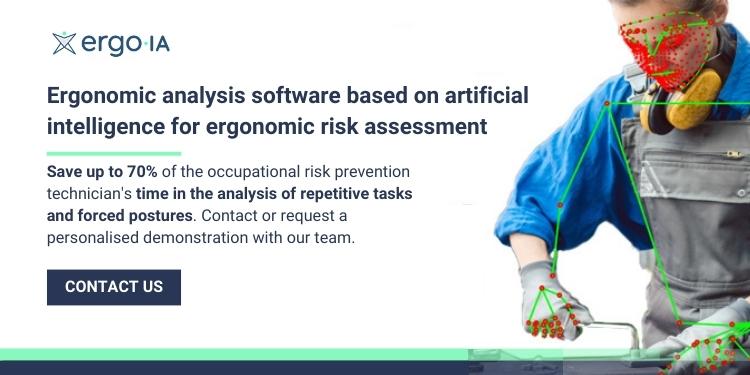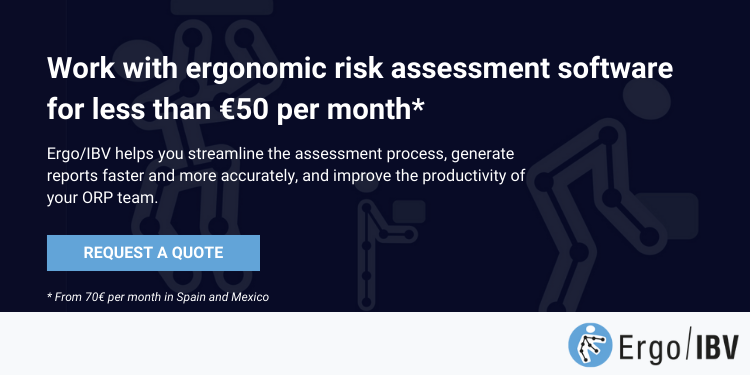The NIOSH lifting equation or method: a guide to assessing load lifting
Manual load lifting is one of the main causes of musculoskeletal injuries in the workplace and can have a significant impact on the health and productivity of workers. It is therefore essential to have risk assessment tools, such as the NIOSH lifting method or equation, which assess the risk of low back injury from manual lifting and provide a systematic assessment of the ergonomic risk factors involved in these tasks.
In this article, we examine the NIOSH Method in detail and its application to ergonomic risk assessment. We also analyze the Ergo/IBV manual load handling modules, a solution for assessing the lifting, carrying, pushing, and pulling of loads.
Finally, we will see how using the NIOSH lifting equation in conjunction with other methods provides a more complete assessment when tasks require a combination of actions and efforts when manually handling loads.
The NIOSH Method: What is it?
The NIOSH Method is an ergonomic risk assessment tool based on the calculation of the Lifting Index (LI); a relative estimate that measures the risk of musculoskeletal injuries associated with the manual lifting of loads in the workplace:
LI = load lifted / recommended weight limit.
It was developed in 1981 by the National Institute for Occupational Safety and Health (NIOSH) in the United States and has become a globally accepted method of assessing the lifting capacity of workers.
Knowledge of this method, and more specifically of the NIOSH lifting equation on which it is based, is very important as it has served as the basis for the subsequent development of other more recent assessment methods such as the INSHT Technical Guide or the ISO Standard 11228-1.
The NIOSH Lifting Equation: How is it calculated?
The NIOSH lifting equation is a mathematical formula that determines the maximum weight a person can safely lift in a manual load lifting task. This equation takes into account criteria for detecting muscle fatigue. These include the frequency of the task, the duration of the lift, the lifting conditions or the total load lifted in a given period of time.
The equation has been developed using three criteria to determine the load limit:
- Biomechanical: takes into account the load on the spine and sets limits to reduce the risk of spinal injury.
- Physiological: considers muscle fatigue and the recovery required to reduce the risk of muscle injury.
- Psychophysical: refers to the worker’s subjective perception of his or her workload.
In 1991 the equation was revised to include new factors such as asymmetric load handling, task duration, lifting frequency and grip quality. Three years later, a final revision was carried out to complete the description of the method and the limitations of its application. Since then, the Recommended Weight Limit (RWL) has been calculated using seven factors:
RWL = LC · HM · VM · DM · FM · AM · CM
- LC: Load Constant.
- HM: Horizontal Multiplier factor
- VM: Vertical Multiplier factor
- DM: Distance Multiplier factor
- AM: Asymmetric Multiplier factor
- FM: Frequency Multiplier factor
- CM: Coupling Multiplier factor
The role of the NIOSH method in the prevention of musculoskeletal injury
The NIOSH method is a great ally for prevention officers, as it allows them to analyze existing lifting tasks, identify risk factors and make changes or redesign workstations to improve conditions.
The method can be used to evaluate the design of the workstation, considering aspects such as the height of the load, the distance to the point of destination, the space available and the need for mobility. Where risks exist, tasks should be redesigned based on the factors identified by the method. Changes can be quantified by the results of the equation and then translated into specific actions, such as removing obstacles, reducing the weight of objects, or using lifting devices.
Evolution of the NIOSH Method: Ergo/IBV MHL Modules
The methodology used in the Ergo/IBV manual load lifting software modules is an evolution of the NIOSH method.
Available in 4 software modules, the Ergo/IBV manual load lifting ergonomics software methodology is an evolution of the NIOSH method as its development includes that methodology as well as other standards and regulations such as:
NIOSH Method
As we have discussed throughout this article, NIOSH determines the Recommended Weight Limit (RWL) for lifting a load to be considered safe. Its main purpose is to prevent the risk of low back pain or back problems, which account for 20% of workplace injuries.
ISO 11228-1
This is an international standard designed to provide a framework for ensuring the health and safety of workers who manually handle loads greater than 3 kg.
Specifically, it provides guidelines for the prevention of musculoskeletal injuries and other associated risks such as task assessment, selection of handling techniques and equipment, ergonomic recommendations for posture, worker education and training, performance monitoring and evaluation.
UNE-EN 1005-2
This is a European standard that provides ergonomic recommendations for the design of machinery that requires manual handling. It applies both to the manual handling of these machines and to objects processed by them that weigh 3 kg or more and are transported over distances of less than 2m.
It also provides keys to risk assessment in relation to lifting, lowering and moving loads during the assembly, transport and commissioning, operation, troubleshooting, maintenance, preparation, training, process changes and decommissioning, disposal and dismantling of machinery.
INSHT Manual Handling Technical Guide
This guide provides criteria and recommendations for the assessment and prevention of risks associated with the manual handling of loads. Its aim is to identify those tasks where there is an unacceptable risk, and where a redesign or more detailed assessment is required. This involves 4 steps:
- Check whether the tasks are susceptible to risk.
- Eliminate manual handling of loads by automating or mechanizing processes.
- Implement aids to facilitate handling when tasks cannot be automated or mechanized.
- Assess the risks of residual manual activities and determine whether they are acceptable.
Learn more | Repetitive Movements at Work: Risks, Injuries and Prevention
Features and benefits of the Manual Load Handling Module
The Ergo/IBV software is very useful for identifying risks, taking corrective action and improving the productivity and efficiency of processes involving the manual handling of loads. Specifically, it has 4 different modules:
Manual Handling of Loads – Single and Multiple
It enables the analysis of tasks involving the lifting, carrying, pushing and pulling of loads, as well as combinations of these actions.
Tasks in which the variables associated with the MHL do not change significantly (e.g., lifting, pushing and pulling) are classified as simple tasks, and those in which the variables do change significantly, making it necessary to divide the action into sub-tasks (e.g. a transport or a combination of several simple tasks) are classified as multiple tasks.
Manual Handling of Loads – Variable
This module is used to analyze manual load lifting tasks with high variability in the handling conditions (weight, height and/or depth), i.e. resulting in 10 or more different sub-tasks.
Its application requires that the weights of all the loads lifted by the worker during a shift be indicated, together with the corresponding lifting frequencies. Although the calculation is based on the criteria of the classic NIOSH lifting equation, it simplifies the input and subsequent analysis of a large amount of data.
Manual Handling of Loads – Sequential
This module makes it possible to analyze several different manual lifting tasks that are performed in a certain sequence throughout the working day, regardless of whether they are single, multiple or variable.
This module also follows the basic criteria of the NIOSH lifting equation but incorporates a specific procedure for the analysis of sequential tasks, which means that the assessor must define how the rotation of tasks is organized throughout the working day. With this information, the software performs the calculations to determine the level of risk to the dorsolumbar area.
Manual Handling of Loads – Injured Workers
This module makes it possible to analyze manual lifting tasks in workers with low back injuries (specifically, musculoskeletal strain, sprains and non-specific low back pain, excluding other more serious pathologies). Its main objective is to minimize the risk of recurrent disorders when the worker returns to his or her normal duties.
For all these reasons, the NIOSH method has been positioned since its inception as the tool par excellence for assessing the risks associated with manual lifting and redesigning workplaces accordingly.



